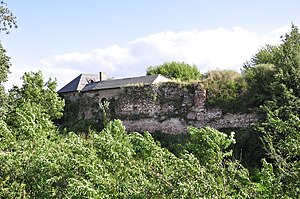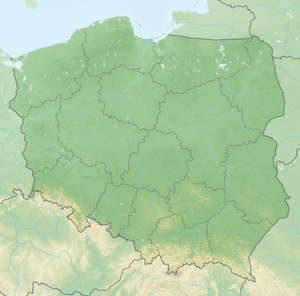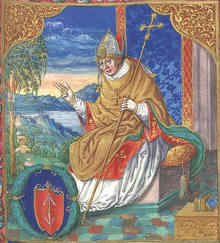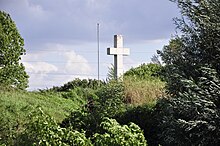Castle ruin Łowicz
| Castle ruin Łowicz | ||
|---|---|---|
|
Ruins of the castle, north side 2010 |
||
| Creation time : | 1355 | |
| Conservation status: | ruin | |
| Standing position : | Episcopal Castle | |
| Place: | Łowicz | |
| Geographical location | 52 ° 6 '38.8 " N , 19 ° 55' 44.9" E | |
|
|
||
The ruins of the fortified castle of Łowicz , located on the western outskirts of the Polish city of Łowicz in today's Łódź Voivodeship , was an important archbishopric in Masovia from the 14th to the 17th centuries . It has been in private hands since 1993, is archaeologically evaluated and should be preserved.
location
The former castle complex is located around 300 meters from the current course of the river Bzura and directly to the west on today's road 14 (here called ul.Zamkowa and ul.Podgrodzie), which connects Łowicz with the voivodeship capital Łódź and has recently become part of the strong as European route 30 traveled route Warsaw - Poznan or Berlin. The ruin is surrounded by a picket fence and grown in.
history
Originally there was a reinforced wooden residential complex on the site of today's stone ruins. It belonged to the Mazovian princes ( Piasts ) and ruled a crossroads of important trade routes. Probably from the 11th century the seat of a castellany was here and since the 12th century the buildings belonged to the Archdiocese of Gniezno .
Castle construction
Around 1355 the Archbishop Jarosław Bogoria Skotnicki had a Gothic castle built in the same place and established his main residence there. The castle quickly became the ecclesiastical and economic administrative center of the region. In the following centuries the fortified palace was expanded several times and became the residence of the Primate of the 1st Polish Republic . Jan Łaski developed a brisk construction activity here.
Important kings ( Casimir II , Casimir the Great , Sigismund II August , Sigismund III Wasa , Johann II Casimir , Johann III Sobieski and papal ambassadors (nuncios Lipomano, Commendone) and the legate Possevino) stayed in the castle .
structure
The fortified facility consisted of two parallel buildings and - depending on the stage of expansion - one or more towers. The so-called "Upper Palace" served Polish kings and their representatives. The representative “royal room” there was furnished with portraits of Polish kings, princes and Gnesen archbishops. The "Lower Palace" consisted mainly of living rooms. As in the “Upper Palace”, there was a chapel here, as well as courtrooms.
In the second half of the 16th century, the palace was redesigned in the Renaissance style under the primate Jakub Uchański . As part of the renovation, the defenses were also expanded.
A music hall and library were built under Wawrzyniec Gebicki . His successor Henryk Firlej renovated the altar in the main chapel. Also in January Wężyk continued the construction of its predecessor - including a front gate and a bathhouse in the garden.
destruction
The heyday of the city and thus of the castle came to an end with the Potop . During the Second Northern War , units of the Swedish King Karl X. Gustav occupied the castle. First of all, the Swedish occupation reinforced the fortifications due to increasing attacks by insurgents, including a ravelin on the southern flank. Despite frequent attempts by the Poles to retake the castle, the Swedes were able to hold it that way for a longer period of time. When they withdrew in 1657, however, they blew up the facilities.
The Primasse Mikołaj Prażmowski , Theodor Andreas Potocki and Adam Ignacy Komorowski tried to restore the former importance of the bishopric, but the relocation of the residence, first to Skierniewice and later to Warsaw prevented this.
Finally, the clashes over the Confederation of Bar again caused considerable damage, this time caused by Russian troops. The castle was partially rebuilt again in the 18th century and used as a production facility for canvases under Archbishop Michael Poniatowski . However, during the Prussian rule after the Second Partition of Poland , it was destroyed again around 1800. From then on it was only used as a quarry for new buildings in Łowicz.
Before the destruction, parts of the still preserved lapidaries were taken to Radziwiłłowa Park Arkadia and to the estate of General Stanisław Klicki . In the romantic Klickis Palace, there are bas-reliefs, consoles and window frames from the Łowicz Castle built into the walls.
From 1914 to 1918 the site was used as a military cemetery. Between the two world wars, excavations and thus the first archaeological research on the complex took place. The ruin has been privately owned since 1993. Guided tours of the remains can be arranged by telephone.
References and comments
- ↑ according to Poland. Baedeker Allianz travel guide (see LitVerz.)
- ↑ Jarosław Bogoria Skotnicki, (more precisely: Jarosław von Bogoria and Skotniki) approx. 1276-1376, came from a Polish noble family. He was Archdeacon of Cracow and Canon in Kuyavia and Gniezno. From 1331 to 1337 he held the office of chancellor in Kuyavia. On July 8, 1342 he was by Pope Clement VI. appointed Archbishop of Gniezno in Avignon . In addition to Łowicz, he also had castles built in Uniejów , Kamień Krajeński and Opatów during his tenure . In 1374 he resigned from office due to blindness and retired to a monastery.
- ↑ probably the cardinal priest of Santa Maria degli Angeli e dei Martiri, Giovanni Francesco Commendone (1574–1584)
- ↑ probably Antonio Possevino
- ^ Henryk Firlej (1574–1626) was a Polish primate, sub-chancellor of the Polish crown and crown trainee.
- ↑ Jan Wężyk (1575–1638) was Bishop of Posen, Archbishop of Gniezno, from 1627–1638 a Polish primate and 1632 and 1633 Interrex of the 1st Polish Republic .
- ↑ Mikołaj Prażmowski (1617–1673) was Archbishop of Gniezno, Primate of Poland and Interrex
- ^ Adam Ignacy Komorowski (1699–1759) was Archbishop of Gniezno and a Polish Primate
- ↑ according to Reinhold Vetter, Between Wisła / Weichsel ... (see LitVerz)
- ↑ Helena Radziwiłłowa, b. Przeździecka (1753-1821) was the wife of Michał Hieronim Radziwiłł and the creator of the gardens in Arkadia.
- ↑ Stanisław Klicki (1775–1847) was a Polish aristocrat and general in the Polish army. For his achievements during the Napoleonic Wars , he was made baron of the French Empire by Napoleon Bonaparte . In the November uprising he commanded the Polish units on the east side of the Vistula. Klicki was buried in the Roman cemetery of Campo di Verano .
literature
- Reinhold Vetter: Between Wisła / Vistula, Bug and Karpaty / Carpathian Mountains , in: Poland. History, art and landscape of an old European cultural nation , DuMont Art Travel Guide, 3rd edition, ISBN 3-7701-2023-X , DuMont Buchverlag, Cologne 1991, p. 210
- Poland. Baedeker Allianz Travel Guide , Verlag Karl Baedeker, ISBN 3-87504-542-4 , Ostfildern 1993, p. 282.
Web links
- Website of the city of Łowicz on the castle (in German)
- Detailed information with views from the 17th century at Zamkipolskie.com (in Polish)



